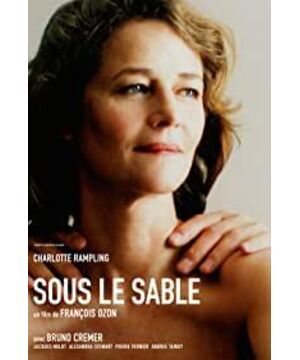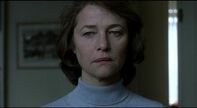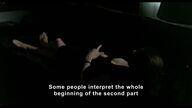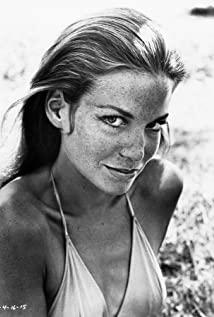Marie lay on her back on the bed, fantasizing that two men, one left and one right, took off her shoes, stroking her legs, then her body, then her face. The hands of four weather-beaten men stroked her face. She closed her eyes, her face filled with infinite satisfaction, and at this moment, the wrinkles on her face seemed to disappear. It was a smiling face in mourning, with no pain in sight. Her hands caressed them cherishly, as if to make sure that twice as many Jeans were by her side. One face, six hands, the whole shot becomes amazingly crowded!
François Ozon is quite concerned about some extreme behaviors of British female writers, which is more fully reflected in his only English-language film "Swimming Pool". In Under the Sand, Marie is a university teacher who teaches English literature and is obsessed with the novels of Virginia Woolf (1882-1941, British female writer and feminist). She murmured twice reading Woolf's words in "The Waves": "I lost my youth...I had a feeling I was going crazy, I heard voices, I couldn't focus my mind on work. I tried to work with Fight, but I can't keep fighting anymore. You gave me all the happiness. You are so perfect, but I can't disturb your life anymore." This passage is actually Woolf's true feelings, and what she finally left to her husband The suicide note is exactly the same. On March 28, 1941, Woolf filled her pockets with rocks and threw herself into a river near her home.
In the film, the audience and Marie seem to abandon their mission to find the true cause of Jean's death at one point. Marie went back to Paris, gathering and chatting with friends as usual, but nothing seemed to happen. She continued to buy Jean's tie, chatted with him at home, showed him her new red dress...until she discovered the fact that Jean was suffering from depression before disappearing. Did he deliberately arrange it? The seaside police station called and said that a badly decomposed male body had been found. The watch and swimming trunks matched the characteristics she described. She mustered up the courage to identify the body, and when she saw the watch, she burst out laughing, saying that it was not her husband's watch at all. The audience thought it was time for the truth to be revealed, but the truth is forever buried under the sand, never to be touched again... In the
final scene, Marie came back to the empty beach and suddenly saw a figure and her husband Similar men stand far away. She stumbled towards the vague man... The audience seemed to be running with Marie, too, on the beach, zigzagging toward a destination that could never be reached...
It's a typical French ending, Also a typical Ozon-style ending, Ozon explained that the man in the final scene could be Jean, or another man, returning to his old life, or the beginning of another life. At the end, the vague return of the characters is used to show the audience a larger space for imagination. This technique can also be seen in "Swimming Pool".
View more about Under the Sand reviews











